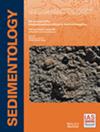莱茵河下游全新世晚期的对位沉积作用
IF 2.8
2区 地球科学
Q1 GEOLOGY
引用次数: 0
摘要
事实证明,蜿蜒河流的河道沉积物远比由粗粒河道、砾石河道滞留层和细粒河岸沉积物组成的著名岩性模型复杂得多。河流的急弯与曲率较低的弯道受不同的水力作用,使内侧河岸受到侵蚀,细粒沉积物沉积在弯道外侧,导致弯道向下游迁移。这种现象被称为对点沉积,形成对点条带。本研究调查了与荷兰莱茵河下游急弯相关的涡卷条是否属于这种对点条状沉积。反点条沉积的预期依据是:(i) 卷轴条的表面形态;(ii) 河道受冰推山脊的限制而形成急弯;(iii) 在冰推山脊顶上连续出现的罗马定居点的考古背景,这些定居点有可能随着河流弯曲的迁移而向下游移动。这一假设通过详细的钻孔描述和光学激发发光测年法得到了验证,后者是确定对点沉积物的一种新方法。这些沉积物由粘土和含细砂层的砂质粘土以及零星的较大砂体组成。再往上游,这些沉积物逐渐变为以含砾石的较粗砂土为主的河道沉积物。这些岩性可以用之前提出的对点式沉积形成机制来解释;底层与之前研究的对点式沉积及其对应的点条式沉积中描述的底层相吻合。光激发发光日期表明,莱茵河下游弯曲处向下游迁移,证实了对点沉积。通过加权线性回归,确定迁移率为 1.93 米/年。这项研究证明了光激发发光测年法在调查对点条带存在方面的潜力。已确定的对点式条石和相关的弯曲迁移提供了对蜿蜒河流动态的深入了解,这对河流管理以及河流恢复和野化计划至关重要。本文章由计算机程序翻译,如有差异,请以英文原文为准。
Late-Holocene counterpoint deposition in the Lower Rhine River
Channel deposits from meandering rivers have proven to be far more complex than the well-known lithofacies model consisting of coarse-grained channel, gravelly channel-lag and fine-grained overbank deposits. Sharp bends in rivers are subject to different hydraulic processes than bends with lower curvatures, enabling erosion of inner banks and deposition of fine-grained sediments in the outer bend, resulting in downstream migration of river bends. This phenomenon is known as counterpoint deposition, forming counterpoint bars. This research investigates whether scroll bars associated with a sharp bend in the Lower Rhine River, The Netherlands, are such a counterpoint-bar deposit. A counterpoint bar is expected based on: (i) the surface morphology of the scroll bar; (ii) the confinement of the river course by an ice-pushed ridge resulting in a sharp bend; and (iii) the archaeological context of successive Roman settlements atop the ice-pushed ridge, potentially moving downstream with the migrating river bend. This hypothesis is tested through detailed borehole descriptions combined with optically stimulated luminescence dating, the latter being a novel approach to identifying counterpoint deposits. The deposits consist of clays and sandy clays with fine sand laminations, and sporadic larger sand bodies. Further upstream these deposits grade into channel deposits dominated by coarser sands with gravels. These lithologies are explained using earlier proposed mechanisms for counterpoint formation; substrata match those described in previously studied counterpoint deposits and their point bar counterparts. Optically stimulated luminescence dates indicate that the Lower Rhine River bend migrated downstream, confirming counterpoint deposition. A migration rate of 1.93 m/year was established through weighted linear regression. This study demonstrates the potential of optically stimulated luminescence dating to investigate counterpoint bar presence. The identified counterpoint bars and associated bend migration provide insight into meandering river dynamics that is crucial for river management and in aiding river restoration and rewilding initiatives.
求助全文
通过发布文献求助,成功后即可免费获取论文全文。
去求助
来源期刊

Sedimentology
地学-地质学
CiteScore
8.20
自引率
11.40%
发文量
94
审稿时长
6-12 weeks
期刊介绍:
The international leader in its field, Sedimentology publishes ground-breaking research from across the spectrum of sedimentology, sedimentary geology and sedimentary geochemistry.
Areas covered include: experimental and theoretical grain transport; sediment fluxes; modern and ancient sedimentary environments; sequence stratigraphy sediment-organism interaction; palaeosoils; diagenesis; stable isotope geochemistry; environmental sedimentology
 求助内容:
求助内容: 应助结果提醒方式:
应助结果提醒方式:


